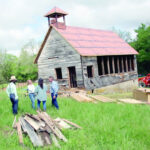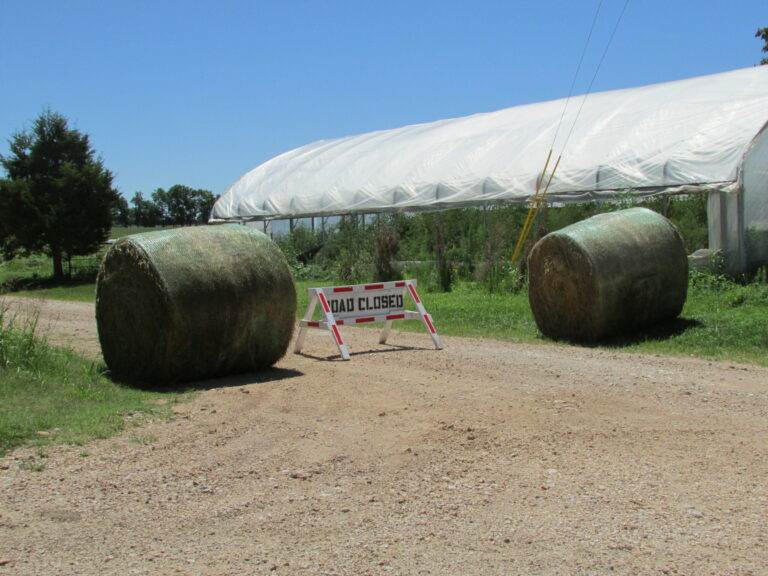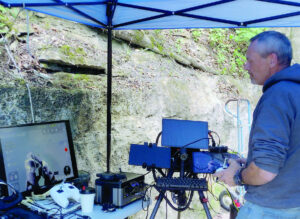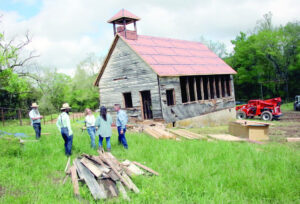Property owner addresses concerns, actions being taken
By Sheila Harris sheilaharrisads@gmail.com
The wastewater residuals lagoon in Fairview has been turning heads in recent weeks due to sight and by smell, forcing action by the company and state officials to remedy the situations.
Brooks McNeill, with the Southwest Regional Office of the Missouri Department of Natural Resources (DNR), put the rumors to rest that the Denali Water Solutions’ Evans lagoon, located between Fairview and Wheaton, had “boiled over.”
“I was contacted by representatives of Denali on Friday, July 28,” McNeill said. “They told me they had been experiencing an unexpected growth of foam from the contents in the lagoon and were trying to fight it. They asked us if we could give them some help.”
McNeill paid an initial visit to the lagoon, located between Wheaton and Fairview in Newton County, on Monday, July 31, and found emergency containment measures by Denali were underway. McNeill said the measures included a series of additional berms constructed around the top of the basin.
“The foam had made it over the top of the berms when I got there, and operators were digging trenches around the inside and outside of the fence surrounding the basin to contain the foam if it continued to grow,” McNeill said.
According to McNeil, the foam had the consistency of whipped cream and was grayish in color.
McNeill said he made additional trips to the lagoon in the weeks that followed.
“The foam filled the space between the trenches on each side of the perimeter fence, but did not go farther,” he said.
McNeill said that at no time did the liquid contents of the lagoon breach the top of the basin.
He said the growth of the foam from the lagoon was an entirely unexpected event. Initial thinking was that it resulted from a bacteria.
“A wastewater treatment contact who I spoke with said certain types of bacteria can foam when exposed to the excessive heat that we had in July,” McNeill said.
On Monday, McNeill notified the Cassville Democrat that Denali Water Solutions has provided results of samples collected regarding the foam at the Evans Basin.
“The results showed a filamentous bacteria in the Methanothrix genus,” he said. “Within that genus there were multiple species that could have caused the issue at the basin. However, a specific species does not appear to have been cited by the third party laboratory who conducted the testing.”
According to property owner, Jerry Evans, there were specialists from labs in five states drawing samples of the foam.
Sam Liebl, director of communications for Denali, said the company is taking action regarding the lagoon.
“Denali closely monitors its storage basins and recently became aware that material had begun to foam in a basin near Fairview, Missouri,” he said. “We alerted the Missouri Department of Natural Resources and have stayed in close contact with the agency as conditions change and as we implement treatment measures.”
According to McNeill, treatment measures included spraying the foam with a 12 percent bleach compound to assist in dissolving it.
McNeill said because of the nature of the bacteria, the growth of foam will likely not be an isolated incident, and operators may have to address it again.
Although the foam is now under control, residual damage was noted by an aerial observer, who reported to the Cassville Democrat that several mature trees were dying where the foam met the tree line.
“I really hate [to lose the trees],” Evans said. “The root systems were probably smothered, would be my best guess.”
McNeill said as it relates to the trees, the contents of the Evans Basin have been reported and documented by the Department. The materials are routinely used statewide as a soil amendment for agricultural purposes, he said.
“The presence of Methanothrix bacteria, while uncommon, can occur in anaerobic wastewater lagoons and holding basins,” he said. “It is unlikely the materials could cause an acute reaction to neighboring woody vegetation. There have been no issues reported to the Department by the landowner, or Denali Water Solutions regarding the issue.”
Korrie Bateman, a neighbor who lives a couple of miles south of the lagoon, said for her, ground concerns come in second to her top priority — the smell.
“I’m sick of it,” she said on Aug. 16. “Right now, it smells so bad outside that we can’t stand to be out there. We can’t have company, we can’t barbecue, we can’t do anything.”
That night was but one of many nights and days where her family has been stuck inside, Bateman said, and she feels as though hers and other citizens’ rights are being violated.
She said the smell emanating from the lagoon is variable and unpredictable and can descend without notice.
“My son plays baseball for Wheaton [two miles southeast of the lagoon, and sometimes the whole town stinks],” she said. “We’ve heard of players and parents from other teams vomiting, and asking if they can play games against Wheaton in another town.
“When one of our neighbors wanted to put chicken houses in, the DNR told him he had to send letters to all of the neighbors letting us know what he planned to do. We got that letter. But with this lagoon, we weren’t notified or asked about anything. They just put the lagoon in, and we didn’t know what was going on until we started smelling the stink.”
Bateman said she and her husband Jeff have lived in their house west of Wheaton for four years.
“It was my parents’ place,” she said. “We bought it from my mother after my dad died, but we would never have bought it if we knew there would be a lagoon going in one year later.”
Bateman said her husband would like to move, but they’re afraid it would probably mean taking a loss on their home, as she heard that a neighbor who lived north of the lagoon did.
“Sometimes I’m ready to do that, to walk away and cut my losses and tell the next person, ‘Here, you smell it,’” she said.
Bateman said she and her husband have known the Evans family their whole life, and she said they are good people.
“After [they put the lagoon in], I’ve lost my respect for them, though,” she said. “I kept quiet for a long time, but about six months ago, I realized that if I don’t say something, it’s possible nothing will ever change.
“There’s money being made off this stuff, but it’s the people at the top making the money, while those of us at the bottom are suffering.”
Bateman feels as though she and other neighbors have been sold out, along with the best interest of the community at large.
“On days that it smells, my eyes and throat burn and I get headaches,” she said.
Flies, too, are a problem.
“We’ve spent money for exterminators and special heat and air filters in an attempt to kill the flies and to keep the smell out of the house, but nothing seems to help,” she said.
The Batemans have lodged multiple odor complaints with the Southwest Regional Office of the DNR.
“I know all of the DNR people by first names because they’ve been here so many times,” she said. “But, I feel like my complaints are getting nowhere, and I don’t know where else to turn.”
Tanya Turner, director for the Southwest Regional Office of the DNR said concerns are investigated as they receive them, within 30 days of receipt.
“During an odor investigation, we visit the location where the caller claims the odors originate,” Turner said. “We determine [whether] odors are present, the wind direction, the possible origination, the temperature and humidity. The investigator then leaves the area to clear their nasal passages of any lingering odors.
“They return to the area and utilize the industry standard equipment: the Nasal Ranger. Once in the location where they had indicated odors, they turn the dial [on the Ranger] to a 7:1 dilution to threshold ratio, which is 7 parts of clean air to one-part odorous air. If they detect odors through the Nasal Ranger, they record the time and location. They then leave the area again for a minimum of 15 minutes to clear any lingering odors from their nasal passages.”
Turner said investigators then repeat the process.
“If they receive a second detection at 7:1 DT ratio within a minimum of 15 minutes apart and within the timeframe of one hour, then they determine a violation may exist. After they have received the two detections, they then must confirm the origination of the odors and whether any exemptions apply.
Turner said odor regulations (10 CSR 10-6.165) have an exemption stating that they shall not apply to the emission of odorous matter from the raising and harvesting of crops nor from the feeding, breeding, and management of livestock or domestic animals or fowl, with the exception of Class IA concentrated animal feeding operations.
This exemption, said Turner, applies to land application activities for the purpose of raising and harvesting of crops. As a result, the investigator must determine if any land application is occurring on the same day, near the area where odors appear to originate. If the investigator determines odors are originating from the Evans basin, [because the basin] is not exempt from the odor regulations, a violation will be issued.
“[Denali] would then have a specified amount of time to respond to the Department with a plan of action,” Turner said. “The plan may take time to implement and the Department will work with the facility to assist them in returning to compliance and thus reducing odors from the source.”
Turner said, since June 13, 2023, the [DNR Air Pollution Control Section] has received 30 concerns regarding odors in the area of the Fairview Lagoon and two for the Longview Lagoon.
“Many of these concerns were filed with the Department within days of one another, so each concern is not investigated individually, but one investigation may address several concerns,” Turner said.
According to Turner, the DNR cited the Fairview facility for odor violations found during three separate investigations. The due date for Denali’s response is Sept. 1.
In the meantime, Evans said he is installing a new fogging system designed to bring the odor from the lagoon under control.
“We are currently installing water lines for the system, then we’ll install three-phase electricity,” Evans said.
Evans hopes to have the new system completed and ready for use in September.
According to Evans, the level of waste in the lagoon has dropped a sizeable amount in the last few days. Part of that drop, he said, involves the installment of a dragline spreading system that allows the waste to be drawn from the lagoon and transferred via conduit across several acres to waiting tractors and spreaders for land application. Brooks McNeill, with the DNR, is aware of the new dragline system.
“The road on the west side of the lagoon [Walleye] is currently closed while we pipe the material across the road to the field on the west,” Evans said. “The road commissioners wanted us to close the road instead of digging and running the line under the road.”
Queens Lace Road, on the south side of the lagoon, is also closed for the installation of water lines for the new odor-control fogging system.
Evans said he apologizes to the community for the problems he’s causing.
“I know I have a bad name right now,” he said. “But, with the results I’m seeing from land-applying the sludge, I still believe it’s one of the best organic fertilizers I’ve run across.”
Evans said the sludge is just chicken-processing waste, and contains “no human waste whatsoever.”
“It sets my crops back a little when I first apply it, but within three to five days, they take off,” he said. “A few other landowners around here have also been convinced of its benefits by seeing the results I’m getting.”
Bateman is not one of those landowners.
“All we and thousands of other people ask is that they get the odor under control,” she said. “We don’t use it, nor do we benefit from it, so we don’t want to smell it, not even one little bit. This is not a normal smell, and it’s sure not a smell you can get used to, and we shouldn’t have to get used to it. If they can’t get the odor under control, then it needs to go.”
If that happens, Evans wonders where all the chicken processing waste will go.








It will effect our environment, our rivers, our wells. Someone needs to step up and close this down. Reports from farmers prove it decreases the health and vitality of their animals. It has leaked in the local streams.
I’ve been watching this since I discovered it in 2017. Farmers put it on fields north of Anderson. We experienced severe flooding on Indian Creek after it was applied to fields up in Eagle Rd at the end of NN state hwy north of Anderson..They have trucks at the top of the hill..no telling what else..
Our lives changed from then on. Floods now are severe. We lost three vehicles, our homes flooded for the first time ..My neighbors home is completely destroyed. Now we are dealing with extreme erosion.Who is going to pay to have large gravel brought in ? My neighbors and I if we want to have a chance in keeping our land.
We can not enjoy our property with quiet enjoyment. Greed has to be stopped.
The top soil from these fields needs to be independently tested, and if found to contain forever chemicals and other dangerous pollutants then farmers in the area who have applied this sludge will need to be banned from using the land for food crops until they are decontaminated – if that’s even possible.
My family and I live directly across the field where the Fairview lagoon is located. Like Korrie Bateman and her family, we also are beyond tired of the smell. The odor is in our house, our cars, on our dogs and even absorbs into our clothing. My son came home from school and said that kids commented about the smell on him all day long. He only went outside before school for approximately 5 minutes before leaving the area on the school bus and the nasty smell got on his clothes that quickly and stayed there all day. We should NOT have to suffer like this! We were never informed of the lagoon going in or asked permission, it was just there and we were left to deal with it. The land owners, Jerry and Diane Evans, recently moved out of the area. I would suspect to avoid the terrible odors they have caused. Not to mention the general hatred the community has for them now.
And it is rightly deserved. We cannot even go outside to enjoy our property. We cannot bbq, go swimming or even sit on our front porch because of the putrid smell and the insane amount of flies that come with it. It take us about 4 hours to mow our property each week and we have to endure that smell the entire time. It is just not right. And we can only imagine the leaching that is happening into the water systems. Jerry thinks that because they are spreading the sludge into the ground that it is somehow a fix. It is not! When it rains the smell is released from the ground and the smell is horrendous. Trees are already dying around the lagoon because of the bacterial growth happening. This should be against the law! This lagoon desperately needs to be shut down!